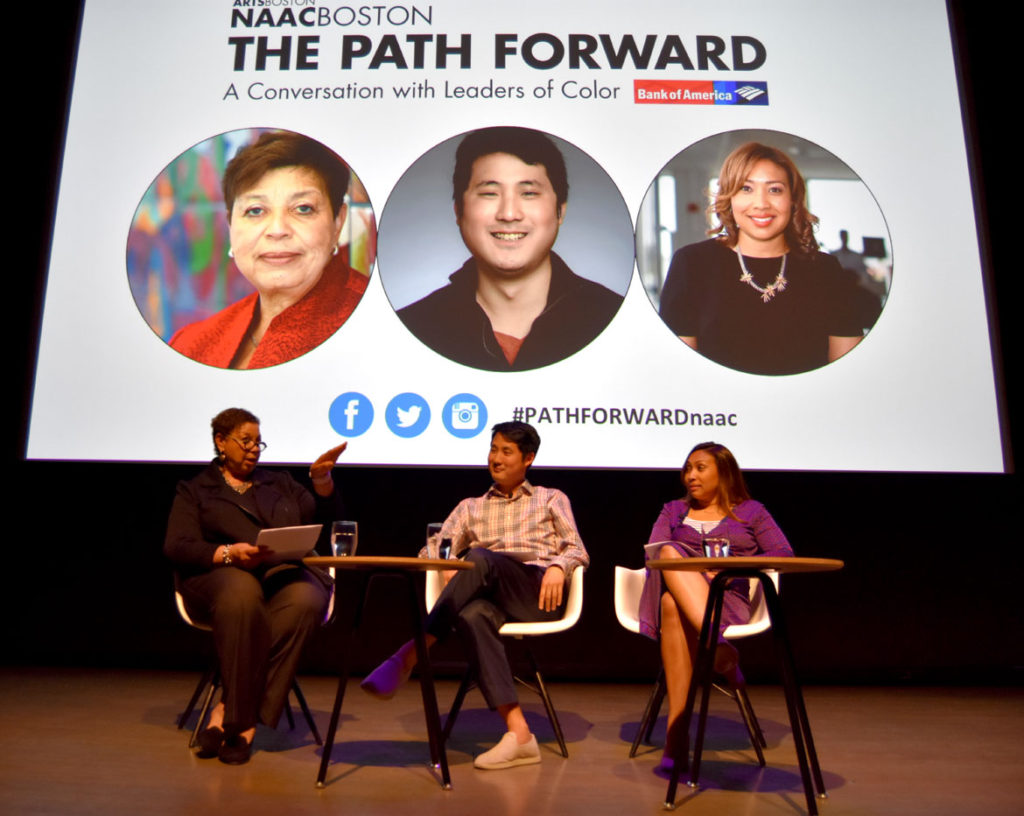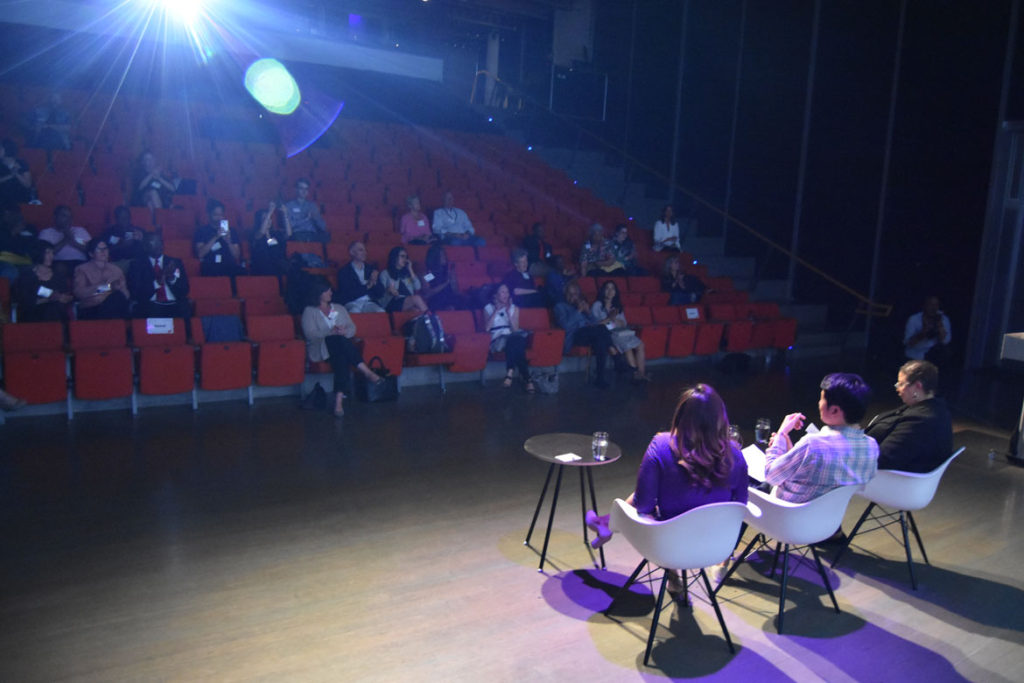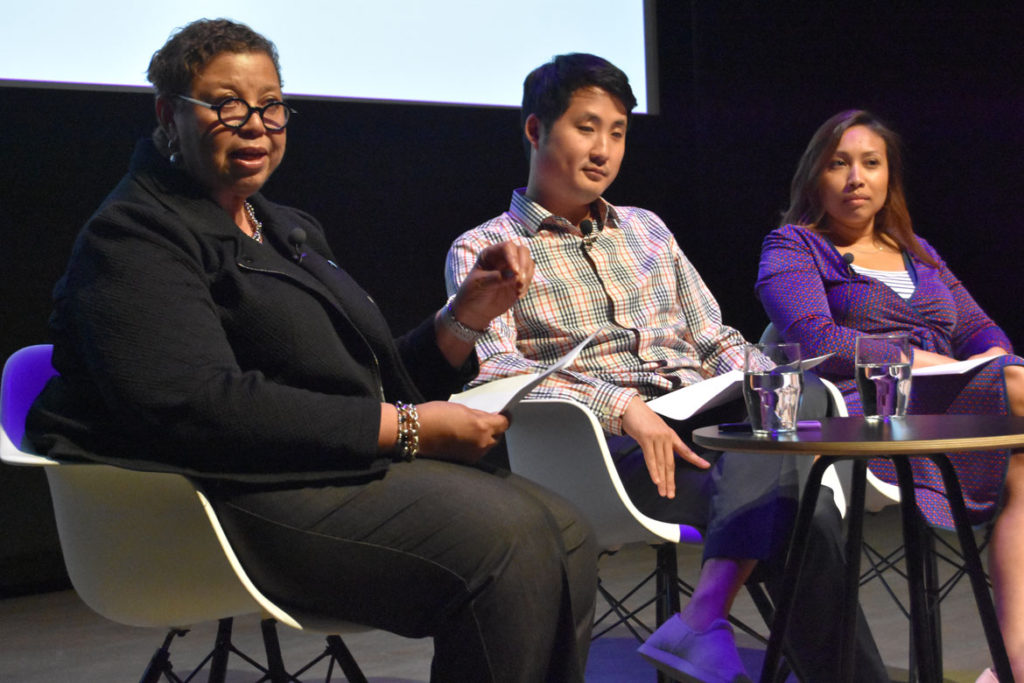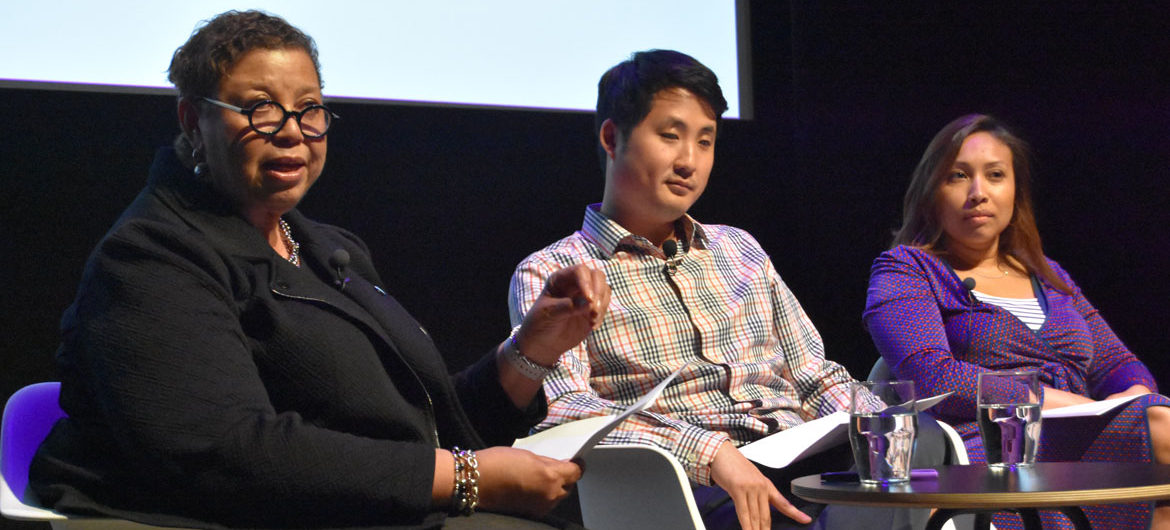In 1970, nearly 70 percent of Boston’s population was white. But according to a 2014 Boston Redevelopment Authority Report, these days, whites account for 47 percent of Boston’s residents—making it a majority-minority community.
But that is not reflected by the number of people of color in leadership positions, said Myran Parker-Brass, executive director for the arts at the Boston Public Schools, at the talk “The Path Forward: A Conversation on Racial Equity in Arts Leadership” organized by the Network for Arts Administrators of Color at Boston’s Institute of Contemporary Art last night.
Young professionals of color are leaving Boston because of the skyrocketing costs of housing and because they feel isolated from other folks of color here, said Justin Kang, vice president for economic growth at the Greater Boston Chamber of Commerce; executive director of the chamber’s City Awake, which aims to nurture the city’s next generation of leaders; and a board member of the state arts advocacy group MassCreative. Later he asked, “How do you make a majority-minority city not so segregated?”
“We definitely have a representation issue,” said Yasmin Cruz, who is involved in client service and strategic planning at the investment management firm Brown Advisory and serves on the board of the ArtsBoston consortium of local arts organizations. She previously worked on community investment strategy for the John Hancock financial firm. “I think things are shifting here.” She said there are more opportunities for mentorship and sponsorship—and those opportunities are offered by more people.
That was the context for the talk the three gave yesterday. “The Path Forward” was the third in a series of conversations presented by ArtsBoston’s Network for Arts Administrators of Color, which was launched in 2016 “to enhance the visibility of professionals of color in Greater Boston’s arts and culture sector, as well as widen the leadership pipeline and highlight opportunities for professional and personal growth in the field.”
More than 200 people are now involved in the group. “The narrative that there aren’t enough leaders of color or arts administrators of color is still a myth that exists in Boston,” network founder Victoria George, also ArtsBoston’s Audience Lab director, noted last night.

Help Wonderland keep producing our great coverage of local arts, cultures and activisms (and our great festivals) by contributing to Wonderland on Patreon. And sign up for our free, weekly newsletter so that you don’t miss any of our reporting.
Much of last night’s panel discussion focused on the relationship between arts and Boston’s business community.
“Arts and culture is completely vital to what we do, especially in talent attraction and retention,” Kang said. Half the city’s workforce is in their 20s and 30s, he said. “Since 2015, millennials are leaving and that’s because other cities are providing millennials with great jobs.” But people say they are attracted to other cities by restaurants and other amenities, he said. “We need to create that emotional connection.”
“Housing affordability is very expensive here,” Kang added. “NY and SF espouse this utopian vision of arts and culture and they will pay that premium to live in those cities.”
Cruz talked of “art as a destination,” that art brings in tourism.
“I and my colleagues need to do a better job of communicating the value” of the arts, Kang said.
“We certainly are a hub given the volume of art serving organizations that are here in the city. It can feel very fragmented by neighborhood,” Cruz said. “Transportation is an issue, so even if there are late night options, transportation is an issue. … We’re not really late night.”
Previous generations of people of color, Cruz said, got into leadership positions and worried about maintaining their positions. “I don’t think the conversation was how do I bring people along? … What does my legacy look like? How am I engaging the next generation?”
Parker-Brass acknowledged, “We came as the only one of those inside an institution. We spent a lot of time putting our stake in the ground. I don’t think we thought a lot about who am I bringing behind me.”

“I think we need to invest a lot more in arts education,” Kang said. “Creativity is the thing that will distinguish us from robots. … The jobs will be given to those who have creativity 25 years from now. We need a workforce that has the ability to think conceptually, to think abstractly.”
“This is a tough environment in the corporate funding community for the arts,” Cruz said. “But education is certainly in many corporations’ priorities.”
From the audience, a woman who identified herself as an architect asked what about people without access to the Institute of Contemporary Art or Boston’s Museum of Fine Arts? “Maybe the ICA should put a little outpost in Roxbury. You need to go where the people are.”
“There’s a tremendous community of color being left out of the arts,” the architect said. “How do we spread the wealth of the arts to the community?”
“If you have a seat at the table bring someone else along with you,” Cruz said. “The reality is a lot of it is shifting things one at a time.”

“From a young age, the best indicator of economic success is who you know,” Kang said.
“We’re getting major institutions to host events for millennials of color,” Kang added. But it’s not just about opening up the Museum of Fine Arts. “It’s about elevating the existing work of institutions of communities of color and getting people to go to that place too.”
“We live in our very siloed communities,” Kang said. “How do you then expand those networks?” He suggested making collaborations and partnerships with communities with which you’re less familiar.
“We need to cross the rivers,” George said. “We need to be mindful of why don’t we find ourselves in those neighborhoods.”
Previously: Dec. 13, 2017: Arts Leaders Of Color Panel: ‘If This Sector Can’t Be Diverse And Inclusive, Who Else Can Be?’
Help Wonderland keep producing our great coverage of local arts, cultures and activisms (and our great festivals) by contributing to Wonderland on Patreon. And sign up for our free, weekly newsletter so that you don’t miss any of our reporting.
